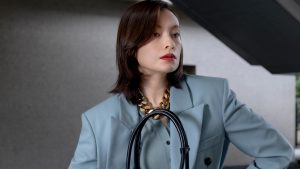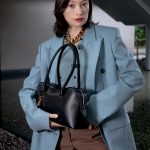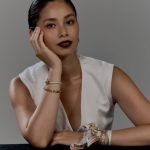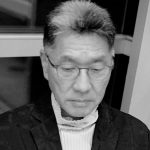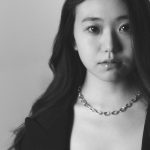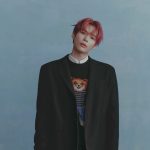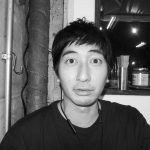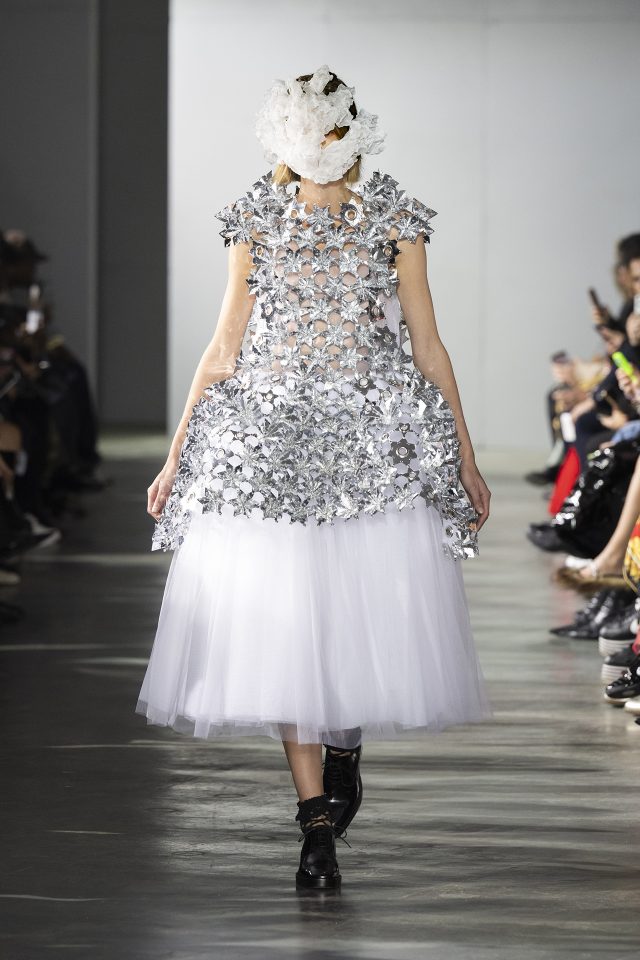ヘアメイクアップ アーティスト・加茂克也インタビュー
Katsuya Kamo
Photography: Takashi Kamei
Interview & text: Miwa goroku
加茂克也が最近なんだか饒舌だ。今年3月には、自身初となる展覧会「Preserved」を表参道のTHE CAVEで開催。原宿VACANTでは高橋盾(「アンダーカバー」デザイナー)とのトークショーを催し、メンズ誌「ヒュージ」の5月号では演出家の若槻善雄との“大放談”に登板、若手にざっくばらんと喝を入れるなどの顔出しが続いている。ファッションショーや撮影などクリエイションの現場では、どことなく近寄りがたい雰囲気を放つ加茂だが、その素顔はすこぶる気さくでフランク。彼がいま、何を見て、何を感じ、どこに向かおうとしているのか。展覧会期中の合間を縫って話を聞いた。
ヘアメイクアップ アーティスト・加茂克也インタビュー
Portraits
*You’ll find the English text after the Japanese.
—初の展覧会、ということでまずはオブジェ的なヘアメイク作品を期待したのですが、フタを開けてみると、標本箱を思わせるアートワークだったので少し驚きました。標本箱といえば、加茂さんのブログ(@ヴォーグ オム ジャパン)で以前ご紹介なさっていたご自宅の壁の写真が頭をよぎります。今回の作品は、その壁にランダムに掛けてあったモノに近いですよね。
近いというか、まさにそれ。今回その壁に置いてある箱から12点選んで、ガラスを入れた。今までフタをしていなかったものにフタをして出したという感じ。
—昆虫の死骸やカピカピのキノコなど、動植物のリアルな“オブジェ”が多く見られますが、これらは長年かけて収集されたものですか?
3、4年前くらいからかな。僕、作る時はだいたい急激に作っちゃうの、仕事みたいにね。一気に作って、フィニッシュしないまま壁に置いておく。そうすると時間の経過とともに変化していくでしょう。フタをしないのも、要は干している状態っていうこと。
—昔から質感にはこだわっていらっしゃいますよね。
人が触って作るものなら、自然にそうなっちゃうよね。もし僕がデザイナーだったら、手縫いのほうが好きかもしれない。サンプルを手縫いで作って大量生産する流れになると思う。
—展覧会開催のきっかけは?
写真家のホンマタカシさん、よくうちに遊びにいらっしゃるんですが、THE CAVEは彼が運営していて。それで次やってよっていわれて、単純にその流れで。話は変わるけど、いまシュタイデル(ドイツのアート系出版社)から本を出す準備をしているところ。ヘアの作品本を今年中に出す予定。今後は、今回のような展覧会も含め、いろいろ見せていきたいなと思っていて。
—楽しみです。アーカイブの写真集のような?
アーカイブではなく、新たに作るつもり。それをウィッグにのせて撮る。ショーだと、その流れの中で見せるだけで、人の記憶には残らないじゃないですか。本なら、質感やディテールまでキレイに見える状態で残せるでしょう。写真は自分で撮ろうかなとも思っている。僕が作るものって、オシャレに撮ったらダメみたいなんですよね。あるいはホンマさんにお願いするかもしれないけど。ホンマさん、先日もヘアを撮りに来てくれたんですが、地明かりだけで撮るんですよ、ライティングとかなし。適当な感じっていうか。でも、適当というのが結果的に強い表現になる場合がある。だから、ホンマさんに教えてもらいながら、自分で撮るのもありかな、と。
—完全にアート本ですね。昆虫なども使ったり?
いや、もっとシンプルに。仕事の延長線上のものだから。基本的には白と黒のグラフィカルな世界で見せたい。
—ショーではヘッドピースが主張するスタイルが多いですよね。加茂さんが展覧会で見せていらっしゃるようなプライベートのアートワーク作品とは、どのようにリンクしているのでしょう? たとえば「ジュンヤ ワタナベ・コム デ ギャルソン」のショーでは、たびたび鳥の羽根が使われていたりしますが。
パッと見てナチュラルに見える状態というのが基本。汚かったり激しすぎたり気持ち悪いものはイヤ。そこはずっと変わらない。
—ナチュラルがキーワードですね。とはいえ加茂さんの仕事はいつも、一目で加茂さんとわかる強い主張も備えています。でも、ファッションと必ず共存させている。そのバランス感覚というかセンスの卓越っぷりに感動します。ファッションとコラボレーションするにあたっては、特にショーだと、事前に作り込む時間が絶対的に少ないと思うのですが、やはり即興的に作っていくのでしょうか?
そう。でも、それがいいみたい。心からそう思えるようになったのは最近ですけど。たとえば写真だと、さんざんいろんな撮り方にトライした挙げ句にやっぱり一番最初がよかったっていうパターン、よくありますよね。でも、僕の場合は違う。最初に作ったものは完全なるサンプルで、それは必ず超えなければいけないものなんです。で、以前は超えるのに2〜3週間かかっていた。だからショーの時なんて、だいたいデザイナーと打ち合わせるのがそのくらいのタイミングだから、すごく恐いですよね。15年前くらいにジュンヤさんに言われたのが、「同じ空気を吸っているからわかりますよね」って。当時は正直、わからない時があった。でも今はわかる。今なら1日でフィニッシュまで持っていける。そういう感覚、最近になってようやくつかめたというか、できるようになった。モノを作っている人たちは、だいたいそうじゃないかな。
—経験値でしょうか?
そう、経験値だと思う。同じ考えを持っている人と共有できる。間違っても同じ方向にいく。だから心配もしないし、ダメだったら仕事しなくていい。最近そういうふうに思う。面白いことに僕、ミスばっかりなのよ。カール(・ラガーフェルド)さんとの仕事にしても、事前にドローイングを送っていただくんですけど、そこに書いてあるものが何なのか、いつも理解不能なの。今シーズン(2012年秋冬)も然りで、パリに飛ぶ前になんとなく用意していたんですけど、実際に見せに行ったら、案の定違う。イチから現場でやり直し。ヘアが決まるのは、もう当日ですよね。
—経験値というものの奥深さを改めて思い知った気分です。成功している方に限って、というと言い過ぎかもしれませんが、トップに上り詰めた方の口から「最近やっとわかってきた」とか「最近上手になった」とかっていう意外なコメントを聞くことは少なくない気がして。
そうだと思うよ。たとえば撮影にしても、いま早いじゃないですか。昔は本当に遅かった。なぜか?単純にわからなかったから。じゃあ次はライトを50灯!とか、いま考えるとバカじゃない?って思うようなことにどんどんトライして試行錯誤していたから。だからその感覚で、ずっと手探りしている。今の若い人たちは、いろんなことを学んだ上で現場に出ている。ビジネス的にもいろんなことをクリアにできて、クオリティもちゃんと守って、みんな若いのに本当にスゴいなと心から思う。こうすればよかったのか!って、僕自身も勉強させてもらっているし。でも若い子たちは、一方で失っているものも多いんじゃないかな。僕のところにぶつかってくる子もいないし。来て欲しいと思っているけどね。
—いまの加茂さんの手もとに残っている、欠かせない七つ道具は?
その時々で好きなもの、かな。極論、何でもいい。たとえばファンデーションもそう。マットなファンデーションでもオイルを混ぜればツヤが出せるわけで。見た目がイメージと同じ仕上がりになればいいという話。だから、新しいものを買わなくてもいいし、そういうわけで道具にはこだわれてない。
—ヘアとメイクとわけて考える場合、加茂さんはヘアの比重が大きいと思いますが、それぞれどう捉えていますか?
ヘアを作り込むときにメイクも盛っていくというのはムリに近い。逆にヘアは何もしなくていいですよという場合なら、顔がスゴいことになっちゃいますね。
—ヘアのこだわりを教えてください。
わりと職人だと思われがちなんですが、実際は真逆。表現することだけが好きなのであって、テクニックとかも磨いていないし、フィニッシュまで行きさえすればいいわけであって、そこまでの過程やディテールは端折っている。4、5年前かな、ヘアのユージーン・ソレイマンに「カモは練習しないの?テクニック落ちるよ?」ってびっくりされたこともある。
—根っからのクリエイターですね。好きな写真家はいますか?
いない。というか、見ようとしていないからわからないです。
—本は?
見ない。心を動かされるモノは、みんなが教えてくれるから大丈夫。そういえば、この1年ですごく感動した写真集が2冊ある。ソニア・パークさんがくれた韓国の写真集。たぶんプロの写真家ではない韓国のお父さんが撮りためた娘の写真なんだけど、あんなにいい写真を見たことはないってくらいよかった。娘の誕生写真に始まりバージンロードで終わるっていうベタベタの展開なんだけど、生活のすべてが出されていて、これがすごくいい。もう1冊は、アーヴィング・ペンのブツ撮り。仕事の資料として目にすることはあっても、ちゃんと見たのは初めてだった。一気にバコーンってやられた感じ。長い時間の経過、たとえば自然に降り積もったホコリだったりが、しかも何度もやり直されている痕跡も含めて、確実に計算されて写し込まれている。僕もちゃんとアトリエを構えて、そういう環境を作ってみようかなと思っちゃうくらい衝撃だった。
—よく見ている雑誌はありますか?
やっぱり見ない。雑誌のことはわからないけど、でも僕の経験上、雑誌はできるだけ個人的であるほうがいいと思う。アナ・ウィンターだってそうでしょう。以前、僕が(米「ヴォーグ」で)携わった写真、数日かけて撮り下ろしたものだったんだけど、結局世に出なかったことも実際にある。それって、アナさん個人が嫌いだったからっていう理由以外にないですよね。あと最近、「SOME/THINGS MAGAZINE」の撮影をやったんだけど、そこの編集者も超個人的で。え!この写真を選ぶわけ?ってびっくりしちゃうくらい。でもやっぱり雑誌はぶっちぎんないとダメですね。サポートしてくれる人、要は広告を取ってきてくれる人が絶対的にいる必要があるけど。
—では、アートは?
こないだパリで、すごく抽象的な絵を買った。意味わからない絵ってあるでしょ。そういうのをワザと買った。何か意味を持たなくてもいいんだと思うように、買ってみた。好きなものは直感でわかるよね。それがすごく大切なことで、なぜ?とか思わない方がいい。誰が何といおうとこれが好きだっていったら、それに賛同してくれる人はいる。不安になるときもあるだろうけど、しょうがない。
—その瞬間に好きなもの、という話になると、時によって天の邪鬼のようにもなりますね。
そうそう。話は戻るけど、アーヴィング・ペンに心底打撃をうけた次の日には、飛行機で隣になった人が観ていたソフィア・コッポラの映画の超モダンな感じってイイな、とチラ見しながら思ったりもするわけ。
—寝ていますか?
睡眠はあまりとらない。やらなきゃいけないことを作ってしまうし、やってしまう。
—これからのヴィジョンを。
最近、ある人に会って考え方が開けた。神道に通じている方で、僕はこう言われた。「あなたに与えられた義務は表現すること。それで人を感動させることがあなたの世間への貢献になる」ってね。僕は基本的に占いとか信じていないけど、それまで自分がやってきたことや、人に助けられてきた部分を客観的に捉えたりすることもなかったから。その人の話をきっかけに考え方が変わったというか、これからについて考え始めたのは確か。たとえば僕、けっこうジジイになったなと思い始めていたところだったんだけど、だからといってカール・ラガーフェルドが78歳で今の状態にあることについてとか、深く考えたことはなかった。でも最近、自分が70歳になった時のヴィジョンを初めて描き出している。今のままのスタンスで仕事しているだろうな、ということなんだけど。子供の人生との擦り合わせもあるけど、20年後はパリで仕事をしているかもな、とか。そういうことを考え出したら、楽しいよね。変わらない部分は変えられない。でもそこを意識することで、逆に目標が見えてくる。
<プロフィール>
加茂克也 (かもかつや)/ヘアメイクアップ・アーティスト
1965年福岡県生まれ。1988年からモッズ・ヘアに所属。1996年から「ジュンヤ ワタナベ・コム デ ギャルソン」と「アンダーカバー」のパリコレクション、2008年からは「シャネル」「フェンディ」なども手掛け始める。東京では、「ミントデザインズ」「アンリアレイジ」「G.V.G.V.」などのヘアメイクを担当。国内外の雑誌のエディトリアルでも幅広く活躍中。03年、「アンダーカバー」(02年春夏/通称SCAB期)のヘアメイクで、毎日ファッション大賞グランプリ受賞。昨年からはパリのヘア&メイクアップエージェンシー CALLISTE にも KAMO の名前で所属。
Katsuya Kamo has been quite talkative recently. This March, he saw the opening of his first solo exhibition, ‘Preserved’, at THE CAVE in Omotesando. He participated in a talk session with Jun Takahashi, the designer of UNDERCOVER, at VACANT in Harajuku. He also had a long chat with Yoshio Wakatsuki, the famed stage director, in the May issue of HUGE magazine. Though he may seem slightly unapproachable on the backstage at fashion shows and fashion shoots, he is actually a very frank and open-hearted man. We met him during the exhibition period and interviewed him about exactly what he is following and feeling and where he is heading now.
—For your first solo exhibition, I was expecting to see some art pieces which would be related to hair and makeup. I was a little surprised to see the exhibits displayed like specimen boxes instead. These pieces reminded me of the pictures on the walls of your house, which you once showed on your VOGUE HOMMES JAPAN blog. Your recent exhibits are similar to the works which hang upon your own walls.
They are exactly the same thing. I have picked up twelve pieces from those boxes on the walls and I have placed glass lids on the boxes which didn’t have covers before.
—Many of your pieces are made up of real objects, like dead insects or dried mushrooms. Have you been collecting these materials over a long period of time?
I began collecting them about three or four years ago. When I make those pieces, I do so rapidly, like I would do with a normal job. I make them all at once and leave them in an unfinished state on the walls. They start changing as time goes by. I leave them uncovered because I want to dry them out.
—You have always been very particular about the feel of your materials.
I’m naturally bound to be this way because I create with my hands. If I were a fashion designer, I would prefer to sew my work manually. I would hand-sew samples and then produce the final line in large quantities.
—What made you want to hold a solo exhibition?
THE CAVE is run by Takashi Homma, a famed Japanese photographer. He often comes to my place, and one day, he asked me to plan an exhibition for his gallery. Very simply, that’s how it happened. Incidentally, I’m in the middle of preparing the launch of a book with Steidl, the German arts publisher. This book is about my work with hair and it will come out later this year. From now on, I want to present my work in a wide variety of ways. The exhibition at THE CAVE is an example of this new resolution of mine.
—We’re really looking forward to that. Is the book going to be like an archival photography book?
No, I’m going to make new pieces, put them on wigs and shoot them. You can present your work in fashion shows, but the images don’t necessarily stay fixed in people’s memories. On the other hand, if you make a book, you can present your work in a beautiful way, ensuring that the readers can see the details and the feel of the materials. I think I’m going to shoot my work myself. It looks like it’s not really a good idea to shoot my work in a smart way… or I might ask Homma-san to shoot for me. He came over the other day to shoot my hair pieces, but he didn’t use any lighting. He shot them only with base lighting. He did it very casually, but this type of casualness sometimes results in the emergence of strong expression. Therefore, I’m thinking of shooting my work by myself while also asking for his assistance.
—So your book is going to be an art book. Will you be using insects again?
No, I plan for this to be simpler. The book is essentially going to be an extension of my professional work, so I want to show a graphical world in black and white.
—In fashion shows, your headpieces often tend to be conspicuous. How do they link to your private artwork shown at your exhibition? You often use birds’ feathers for Junya Watanabe COMME des GARÇONS.
I want my work to basically appear natural at a quick glance. I don’t like it if it’s dirty, too extreme or too gross. I’ve always been consistent on that point.
—‘Naturalness’ is a key word in describing your work. However, your work also stands out with its distinctive identity and it always coexists with fashion. I’m really impressed with the way you manage to balance naturalness and fashion. When you work in fashion – and especially when you work on a show – you probably don’t have much time to prepare pieces in advance. Do you then improvise?
Yes, I do improvise. I guess that’s a good thing. It’s not until recently that I’ve come to think this way. If you photograph something, you can experiment with many different ways of shooting, but you often end up going for the first take. However, in my case, it doesn’t necessarily work like that. The first piece I make is just a sample and I can never fail to create something better later on. It used to take me a few weeks to produce something better than a sample, and therefore, I used to be nervous about doing hair for the catwalk. After all, you usually start having meetings with designers a few weeks before the show. Junya-san said to me about fifteen years ago, “You should be able to understand what I want to do because both of us are breathing the same air.” In all honesty, sometimes I had no clue what he wanted. However, I understand his meaning now. Now, I only need one day from start to finish. It’s not until recently that I’ve come to be able to do this. If you are someone who creates, you should be able to understand this kind of thing.
—Are you talking about experience?
Yes, I am. I’ve recently come to believe that if you can share the same idea with someone, you two will go in the same direction, even if you get things wrong. There’s no need to worry. To my surprise, I’ve been making quite a lot of mistakes lately. When I work with Karl Lagerfeld, he sends me his drawings beforehand, but I always have no idea what these drawings are really about. I fell into the same situation this 2012 autumn / winter season. I prepared some work before flying over to Paris, but when I showed it all to him, he told me that I’d got it wrong, just as I’d expected. I had to start making something else from scratch on the spot. The final hairstyles were ultimately determined on the same day of the show.
—I’m starting to realize again how just deep and important experience is. It seems quite rare to hear hugely successful people say, “It’s only recently that I’ve started to get it right,” or, “These days, I’m only just getting the hang of it.”
It’s experience that matters. Shooting a fashion story used to take ages, but it takes much less time now. Why? People back then just didn’t know how to do it properly. Sometimes they would use fifty lightings. That sounds ridiculous now, but they were just learning by trial and error. I’m still doing the same kind of thing. Young people now go to shootings after learning a great deal. They are good at business in many ways and their works are great. I admire them from the bottom of my heart. I actually learn from them myself. And yet, having said all this, young people also seem to be losing a lot. None of them try to challenge me. I want them to, though.
—What tools are indispensable for you at the moment?
They vary from time to time, but to speak in extreme terms, they can really be anything. Let’s take foundation cream as an example. If you mix a matte foundation with oil, it will become glossy. Any product will do, so long as I can create the image in my mind with what I have. I don’t have to buy new stuff. I’m not fussy about tools.
—If one separates hair styling from makeup, one can see that it’s hair styling that you do more of. How do you view these two genres?
When I create a complicated hairstyle, I can’t then apply thick makeup. Conversely, when I don’t have to do much with the hair, I can do complicated makeup instead.
—Please tell us about your attitude towards hairstyling.
People often see me as an artisan, but that’s not what I actually am. I just love expressing something. I don’t necessarily polish up my skills. I just need to be able to finish creating something so it’s like I imagined it in my head. I don’t pay too much attention to the process or to the details of creation. Eugene Souleiman said to me four or five years ago, “Kamo, you don’t practice? Your skills will get worse otherwise.”
—You are such a creator by nature. Do you have any favorite photographers?
Not especially. I don’t look out for anyone in particular, so I really have no clue.
—Do you have any favorite books?
I don’t read books. I get enough moving stories from my friends. However, I’ve found two really great photography books over the past year. One is Korean and Sonya S.Park gave it to me. I imagine the photographs in the book were shot by an amateur Korean photographer. The pictures are about his daughter. They’re so good, I’ve never seen anything better. The book starts with a picture of his daughter’s birth and ends with a picture of her walking down the aisle. It’s a basic story, but it’s so good. The other book contains still photographs by Irving Penn. I’d seen his work in reference to my work, but I’d never had a proper look at his work. That book struck me so hard. The pictures in there were shot in such a well-calculated way. It was so shockingly amazing that I started to think about having my own atelier.
—Are there any magazines that you’ll regularly check out?
I don’t read magazines either. I don’t know much about them, but judging from what I’ve encountered, they should be as individualistic as possible. For example, Anna Wintour. I’ve been involved in a photo shoot for American VOGUE before. It took us a few days to finish the story, but ultimately, it didn’t appear in the magazine. Anna must have disliked it; I can’t think of any better explanation. Recently, I did a shoot for SOME/THINGS MAGAZINE. The editor was also extremely unique. I was like, “What? You seriously want to go for this photograph?”. After all, magazines should ensure that they are totally individualistic, although they absolutely need to have admen on board.
—Do you often seek out art?
I recently bought a really abstract painting in Paris. Some artworks are totally incomprehensible, right? I bought something like that on purpose. I didn’t care whether the piece had any meaning to it. You know what you like by intuition. This is really important and it’s better to not ask yourself why you like it. It doesn’t matter what other people say. Just be honest about your intuition and you’ll find some people who support you. You might feel anxious sometimes, but that’s just life.
—You can sometimes be quite contrary when it comes to talking about what you like at a particular moment.
Yeah. Going back to the previous conversation, after I was deeply moved by Irving Penn’s work, I got on a plane and caught a glimpse of a Sofia Coppola film which the person next to me happened to be watching.. The movie had a really modern feel and I liked it a lot.
—Do you get much sleep at all?
Not really. I’d rather ensure that I make what I have to make. I just get on with it.
—Please tell us about your aspirations for the future.
My vision recently opened up after meeting someone who is an authority on Shintoism. He said to me, “The duty given to you is to express yourself. By doing so, you can then move people and contribute to the public sphere.” I don’t generally believe in fortune-telling, but I’d never subjectively looked at what I had done and at that part of my life which is supported by others. The way I think has changed since I had a chat with him. I’ve definitely started thinking about what to do in the future. I was beginning to think that I was getting quite old, but I’d never seriously thought about things like, say, what Karl Lagerfeld was doing at the age of 78. But for the first time in my life, I’m now starting to picture the scene for when I turn 70. I think I will be working like I do now. I need to consider the life of my child, but I might be working in Paris twenty years from now. It’s so interesting to think about the future, isn’t it? I can’t change what can’t be changed, but I can see a goal by being aware of it.
<Profile>
Katsuya Kamo is a hair and makeup artist. He was born in Fukuoka prefecture, 1965. He has been represented by mod’s hair since 1988. He has worked on Junya Watanabe COMME des GARÇONS and UNDERCOVER shows in Paris since 1996. Since 2008, he has also worked for CHANEL and FENDI. In Tokyo, he is in charge of the hairstyling and makeup for certain Japanese brands, including mintdesigns, ANREALAGE and G.V.G.V.. He has extensively worked for both international and Japanese magazines. In 2003, he won the Mainichi Fashion Grand Prix for his hairstyling and makeup for UNDERCOVER’s 2012 spring / summer collection. Last year, he became part of CALLISTE, the Parisian hair and makeup agency, under the title KAMO.
